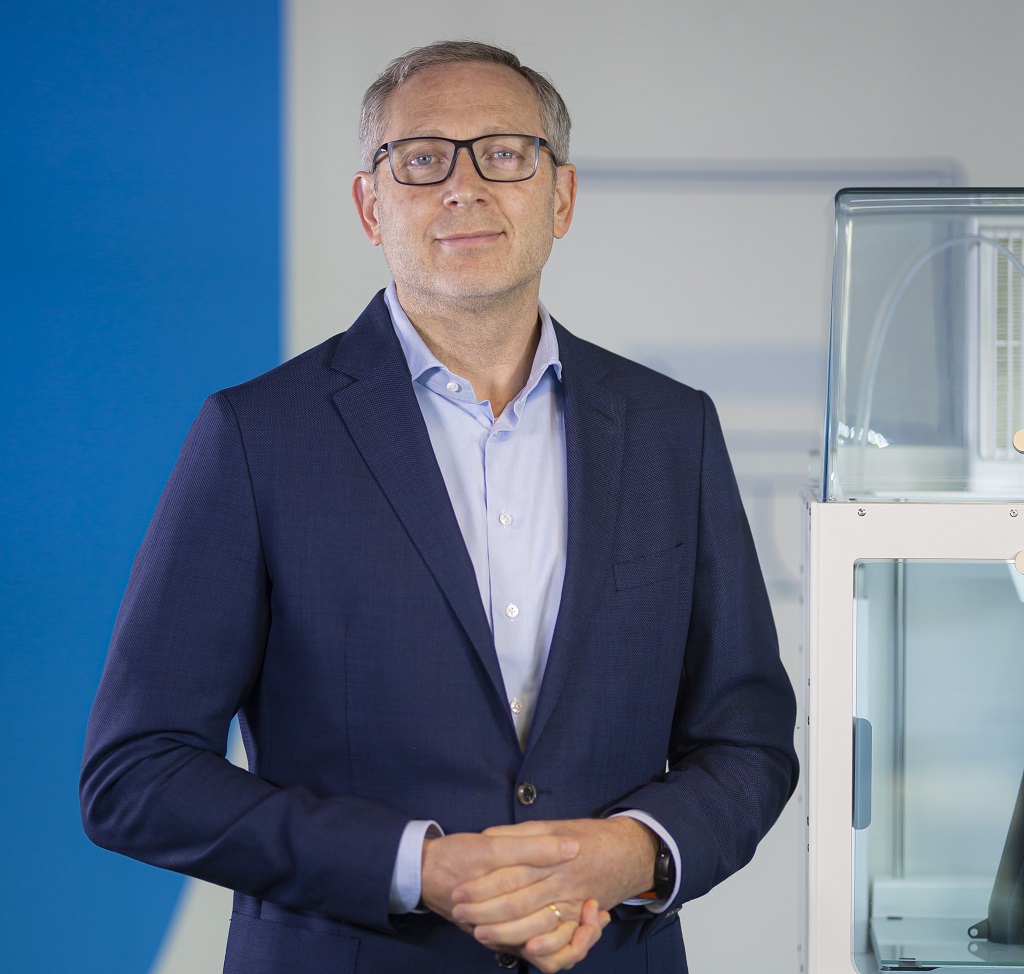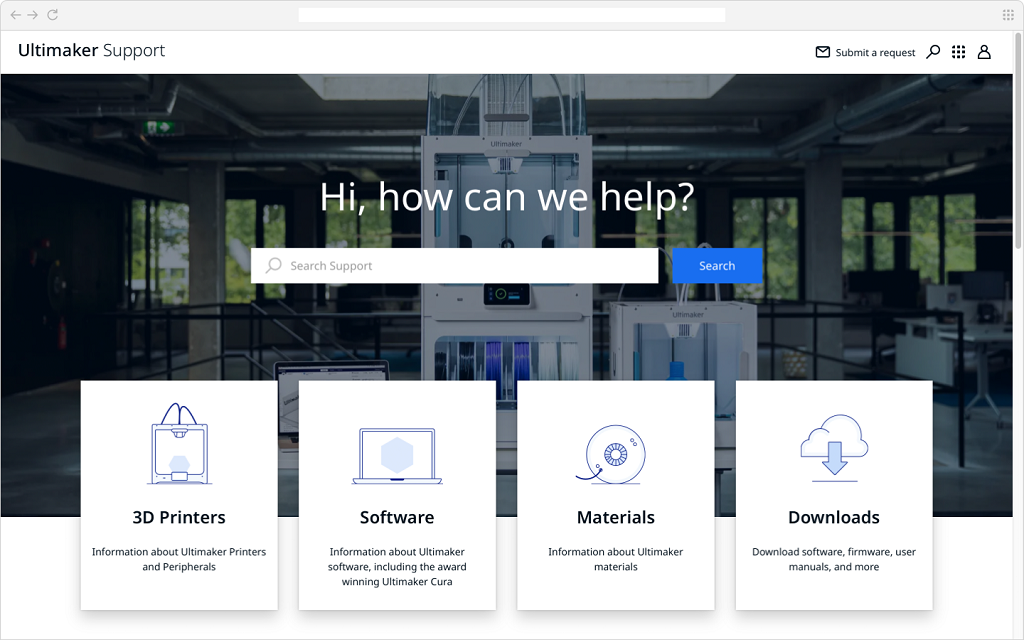
Ultimaker’s new CEO offers an inside look at the company’s strategic shift toward ecosystem thinking.
Today, Ultimaker announced a pivot toward platform thinking along with new software structuring. The Ultimaker Ecosystem is set to advance the next era of innovation and accessibility at the 3D printing company, with the new software options playing an important role in customizing the user experience.
I spoke with CEO Jürgen von Hollen, who stepped into the role at the start of this year and is now ready to implement the next stages of growth for the forward-thinking company.
Ultimaker’s New CEO
In the role now since January 1, von Hollen has had a few months to settle in at Ultimaker. Of course, as with any executive appointment, that settling in has also been with the aim of strategic evaluation in mind.
“I came in from Universal Robots,” he began. “I’ve long been excited by 3D printing, and a customer of 3D printing as well. When I started looking at Ultimaker, I got a feeling of, ‘Wow, they have all these ingredients for success to create something really special.’ And they simply hadn’t married them yet and gotten it all into one package.”
Those ingredients for success are notable, as he laid them out: strong hardware, “equally as strong” software, more than 100 existing partners. All these were there, he noted, “to make this ecosystem work.”
“Over the last three months, it’s been about how to position this and develop a platform to allow the ecosystem to leverage it. Typically when we talk about platforms in this industry, it’s about the software side only. We’re not doing that; we’re doing that plus hardware. We want an open interface, including hardware add-ons to enable this creativity, this innovation,” he said.
“One thing I’ve learned is that every customer’s requirement is pretty specific. I almost wish there was more standardization, but every operation has something unique. To think we could create one solution that could fit everyone — that’s not going to happen.”
With an ecosystem approach, multiple solutions are on the table. Configuring those options to create the best solution for their own requirements allows for the user to design exactly what they need to accomplish exactly what they need to get done.
Even as a newbie to the company, von Hollen immediately understood that this kind of thinking traces deep into Ultimaker’s roots. It’s in their DNA, he noted, with strong ties in the maker community, which has “a culture that is so open and about sharing.”
“This community is always looking for the right solution. It’s not about being superficial, but about true benefit, about true understanding,” von Hollen continued. “With over 150 engineers in the company, we see so much with this thinking, so much opportunity. But how do we get this competence to the end user, who today probably doesn’t see that?”
The opportunity, then, is in conveying the innovative DNA of a company through a product offering. That’s certainly difficult — and the Ultimaker team understand that that goes well beyond clicking the “buy it now!” button on a reseller’s website.
Ultimaker as a Platform
And so today Ultimaker has announced its new strategy, positioning itself as a platform company.
“There’s been a problem in the industry: we haven’t made it simple for the customers. We led with technology,” von Hollen acknowledged. “It makes it hard for the customer to know what to buy. If we simplify that, if we bring in the end user’s perspective, I think we’ll see the industry grow much faster.”
Naturally, Ultimaker is keen to be the spark that ignites that accelerated growth. And so today’s announcements aren’t to be taken lightly. A hardware/software platform approach is, thankfully, something that’s becoming more prevalent today.
For additive manufacturing to truly take off, it needs to be easy, accessible, and understandable. Leading with the technology, as von Hollen noted, can leave non-technological people (read: managerial decision makers who sign the checks) on the outside looking in — with perhaps no desire to step in the door because it doesn’t seem welcoming. So how do 3D printing companies hang, essentially, a large “WELCOME” banner? Make it easy.
“Just the tech alone won’t make us successful. It’s about the go-to-market, about the innovation, about all these things that have to be aligned into our strategy to make them work,” von Hollen continued.
“I think the theory is cool; the implementation is complex. There’s reasons [other] people don’t do it. When you make your decision to go down the ecosystem or platform-based business model, you have to accept that there’s complexity.”
In his case, for example, von Hollen says he “has to accept that I’m no longer the CEO just of Ultimaker; I am also the CEO of an ecosystem of partners, of resellers, of users, all looking to us.”
“When you start thinking about those things, you see that the basis of a good ecosystem is everyone is aligned, everyone has the same vision and focus. There are all these soft things; it’s tough to grab, culturally tough. It takes a lot of time and investment into that,” he said.
The Internal Pivot
It’s complex, yes: so where does a company start?
“We’re going from pure product play to solutions play as well. We’ve got to orchestrate different capabilities to move down that path. The starting point is within our own Ultimaker organization,” the CEO said. “How does one articulate our new proposition using the ecosystem and the platform? What does it mean from a sales perspective? A marketing perspective? An innovation perspective?”
These are the big questions and, of course, there’s no easy answer, no playbook to follow. It’s a process, and it’s a journey that Ultimaker is starting out on now. There is, of course, a roadmap, and it’s one that leaves plenty of room to learn and grow along the route.
First, von Hollen said, is the drive to co-innovate, which is “a whole different game.” Leveraging resources among partners, supporting innovations, generating and accelerating innovation: each step along the way is necessarily cooperative.
A lot of what’s going to happen involves thinking differently. Fortunately, that’s a given in an industry where even design requires different ways of thinking, as we see in the rising DfAM (design for additive manufacturing) discipline. Those skilled in DfAM already have an inherent advantage in thinking differently; it’s already a big part of their job description.
For Ultimaker, a key here is “to bring the right partners, the right competencies, on board,” von Hollen said.
“That’s where a lot of companies get it wrong,” he cautioned. “When a [partner] company gets successful, they want to buy them, to bring that success in-house. However, with complementary activities, together we can create the 1+1=3, instead of just doing it ourselves.”
That is: by keeping focus on an active, partner-driven ecosystem, strength in working with partners leads to a whole greater than the sum of its parts. We’re not looking at an Ultimaker acquisition strategy (right now), despite the overall trends toward industry consolidation.
“We have to define new roles and responsibilities within Ultimaker to orchestrate this. Communities have to be supported, and there are communities on the materials side, on the software side. We have to ask how do we continually develop the APIs, the SDKs, and ensure that everyone is transitioning? If we make a change to the platform, how do we communicate that so everyone knows it? There’s a lot of process and policy to ingrain into the processes of Ultimaker as well,” von Hollen said.
Software Focus

The software portion of today’s announcement is also intriguing, of course. It plays neatly into the overall shift, with an overall solutions focus.
“My belief is it all starts with the customer. And the customer isn’t looking for a 3D printer,” von Hollen said. “He’s looking for a solution.”
A new 3D printing user is suddenly faced with a great amount of learning. Even if they have design files to start, there’s the prospect of slicing, of “all these things I have to do to get to my ultimate product,” von Hollen noted, which might make them nervous.
“If you purchase the Ultimaker platform, there’s an integration of hardware with software that enables it to be a platform, and that’s the starting point. A platform buys you entry to the next levels of capability and competence, as well as to the digital factory, to the library, to learning and the academy: to all the different subscription services available as part of this. On top of this,” he added, “there are ecosystem partners offering their services and solutions.”
A big part of that approach involves ensuring quality via certification.
“Everyone, including us, is developing new markets for customers that are certified. When a customer buys a certified product from the ecosystem — we can here use the analogy of the Apple/Android world; we want to guarantee the user experience,” von Hollen said. “If you don’t use it, it’s your liability; if it’s certified, though, it will work. That’s the concept we want to bring to the customers.”
As the platform approach takes root at Ultimaker, “it will of course evolve,” the CEO acknowledged. But the root concept is the key to it:
“When you as a customer are buying into this platform, you’re buying into this future-proof capability. You know there’s innovation. You can repurpose the platform over and over for different solutions. There will always be more to come, more solutions to leverage,” he said.
Via Ultimaker
